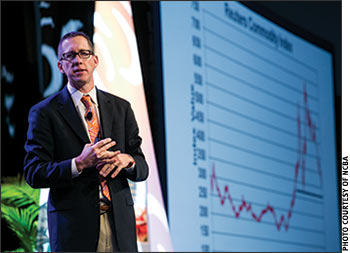Where’s the Beef?
Market analyst sheds light on the current state of beef imports and exports and what 2016 might hold.
Boasting the highest volatility since the bovine spongiform encephalopathy (BSE) crisis a decade ago, today’s markets have producers on the edges of their seats. Despite this volatility, CattleFax Market Analyst and Risk Management Specialist Mike Murphy said we should expect to see exports increase and an overall trend of positivity in the 2016 cattle market.
During the last four to five years, the United States has exported about 2.5 billion pounds (lb.) of beef on a fairly consistent annual basis — roughly 10% of our production, said Murphy. Maintaining that export level, “even throughout all the chaos,” is a big positive for our industry, he said.

During the last four to five years, the United States has exported about 2.5 billion pounds (lb.) of beef on a fairly consistent annual basis — roughly 10% of our production, said CattleFax’s Mike Murphy. Maintaining that export level, “even throughout all the chaos,” is a big positive for our industry, he said.
During the fourth quarter of 2014 through 2015, prices of feeder cattle, fed cattle and calves dropped off sharply. Fed-cattle prices fell from a record high of $167 per hundredweight (cwt.) at the end of 2014 to $128 per cwt. by the end of 2015.
While the cattle market remains positive, Murphy said it’s important to realize the beef industry isn’t immune to the volatility of the grain markets.
“Our markets, in some form in the commodity business, are all intertwined,” he said. “It’s pretty amazing when you step back and you evaluate those correlations.”
Commodity markets are cyclical in nature, he said. The cattle industry skipped the traditional 10-year cycle as supplies have, on average, been in decline since and prices have been, on average, going up since the mid-1990s.
“You can trace these relationships in the markets back to equities,” Murphy explained. “They typically are going in opposite directions of each other. Where commodities are declining, equities are improving and vice versa.”
After the significant push in commodity prices in 2008, those raised prices stimulated production. In the last year, we’ve seen significant corrections to the crude oil and hog sectors, fueled by large increases in production. Demand for those commodities has fallen, pumping the brakes on global demand.
So, what does the United States export market for protein look like in the future?
It’s not too shabby. Murphy said the United States is in “really good shape compared to the rest of the world” and that he can see no concern of a recessionary year.
Countries around the world are lowering interest rates to spark economic growth. Murphy said this act did have a positive effect, but that effect has worn off. Now, interest rates are scraping the bottom of the barrel, and nations are devaluing their currency in hopes of stimulating exports.
Russia has seen a 56% decline in the last 18 months due to the deflationary concept. Brazil’s export market is raising eyebrows in the United States as countries around the world have the opportunity to buy their beef cheaper.
“It’s a different type of product that we ship versus what they ship in terms of quality,” Murphy said, noting the difference in the United States’ high-quality, grain-fed product compared to Brazil’s lower-quality grass-fed beef. However, when economies are leveling off rather than growing, cheaper is better.
“The challenge the U.S. is faced with is that we’re a stable economy,” Murphy said. “There’s no fear of risk, of seeing a decline in the state of our economy, at least not in the short-term over the next one to two years. These other countries are taking over what they need, devaluing their economy and trying to stimulate growth. That hurts us because now we’re less competitive.”
For the supply side of the ledger, Murphy has one word: contraction.
“With beef in particular, we’ve got small increases in global beef production in 2016 — about a 1% increase,” he said. “Go back and look at the last several years: it’s a tight, tight supply.”
That tight supply is due to the anticipation of expansion. Australia and Canada will likely contract their production in 2016 to prepare for herd expansion in the future, Murphy said.
Beef imports have seen a decline of about 8%, Murphy said. There’s also been a decrease in the value of lean beef, which makes up the majority of imports into the United States.
During the last four to five years, Murphy said the United States has exported about 2.5 billion pounds (lb.) of beef on a fairly consistent annual basis — roughly 10% of our production. Maintaining that export level, “even throughout all the chaos,” is a big positive for our industry, he said.
“When we start to look at beef production numbers globally [getting] a little bit bigger in 2016, most of that growth is going to come from the United States,” he said. “That’s going to put us in the position where we should still be able to command better demand from a global standpoint and export a little bit more product.”
Keep monitoring the markets, Murphy urged. After those record-high cattle prices of 2014, the correction has finally come, and come quickly. We may see slow growth in global demand, but prices will likely remain lower in 2016.

Editor’s Note: This article was written as part of Angus Media’s online coverage of the Cattle Industry Convention & NCBA Trade Show. For additional coverage, visit the Newsroom at www.4cattlemen.com.






